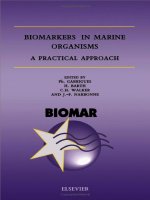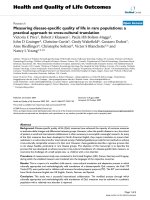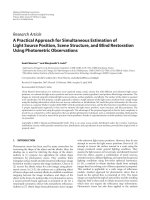protein expression a practical approach - b. d. hames
Bạn đang xem bản rút gọn của tài liệu. Xem và tải ngay bản đầy đủ của tài liệu tại đây (17.04 MB, 303 trang )
Protein
Expression
The
Practical Approach Series
SERIES
EDITOR
B.
D.
HAMES
School
of
Biochemistry
and
Molecular Biology
University
of
Leeds, Leeds
LS2
9JT,
UK
See
also
the
Practical Approach
web
site
at
/>*
indicates
new
and
forthcoming titles
Affinity
Chromatography
Affinity
Separations
Anaerobic Microbiology
Animal Cell Culture
(2nd
edition)
Animal Virus Pathogenesis
Antibodies
I
Antibodies
II
Antibody Engineering
*
Antisense Technology
Applied Microbial Physiology
Basic
Cell Culture
Behavioural
Neuroscience
Bioenergetics
Biological
Data
Analysis
Biomechanics—Materials
Biomechanics—Structures
and
Systems
Biosensors
Carbohydrate Analysis
(2nd
edition)
Cell-Cell
Interactions
The
Cell Cycle
Cell Growth
and
Apoptosis
if
Cell
Separation
Cellular Calcium
Cellular Interactions
in
Development
Cellular Neurobiology
*
Chromatin
if
Chromosome Structural
Analysis
Clinical Immunology
Complement
if
Crystallization
of
Nucleic Acids
and
Proteins (2nd edition)
Cytokines
(2nd edition)
The
Cytoskeleton
Diagnostic Molecular
Pathology
I
Diagnostic Molecular
Pathology
II
DNA
and
Protein Sequence
Analysis
DNA
Cloning
1:
Core
Techniques (2nd edition)
DNA
Cloning
2:
Expression
Systems (2nd edition)
DNA
Cloning
3:
Complex
Genomes (2nd edition)
DNA
Cloning
4:
Mammalian
Systems (2nd edition)
*
Drosophila (2nd edition)
Electron Microscopy
in
Biology
Electron Microscopy
in
Molecular Biology
Electrophysiology
Enzyme
Assays
Epithelial Cell Culture
Essential Developmental
Biology
Essential Molecular Biology
I
Essential Molecular Biology
II
*
Eukaryotic
DNA
Replication
Experimental Neuroanatomy
Extracellular Matrix
Flow Cytometry (2nd edition)
Free Radicals
Gas
Chromatography
Gel
Electrophoresis
of
Nucleic
Acids (2nd edition)
*
Gel
Electrophoresis
of
Proteins
(3rd
edition)
Gene Probes
1
Gene Probes
2
Gene Targeting
Gene Transcription
*
Genome Mapping
Glycobiology
if
Growth Factors
and
Receptors
Haemopoiesis
if
High
Resolution
Chromotography
Histocompatibility Testing
HIV
Volume
1
HIV
Volume
2
*
HPLC
of
Macromolecules
(2nd
edition)
Human Cytogenetics
I
(2nd
edition)
Human Cytogenetics
II
(2nd edition)
Human Genetic Disease
Analysis
if
Immobilized
Biomolecules
in
Analysis
Immunochemistry
1
Immunochemistry
2
Immunocytochemistry
if
In
Situ Hybridization
(2nd
edition)
lodinated
Density Gradient
Media
Ion
Channels
if
Light Microscopy (2nd edition)
Lipid Modification
of
Proteins
Lipoprotein
Analysis
Liposomes
Mammalian Cell Biotechnology
Medical
Parasitology
Medical Virology
MHC
Volume
1
MHC
Volume
2
*
Molecular Genetic Analysis
of
Populations (2nd edition)
Molecular
Genetics
of
Yeast
Molecular Imaging
in
Neuroscience
Molecular Neurobiology
Molecular Plant Pathology
I
Molecular Plant Pathology
II
Molecular
Virology
Monitoring Neuronal Activity
Mutagenicity Testing
*
Mutation Detection
Neural
Cell Culture
Neural
Transplantation
Neurochemistry (2nd edition)
Neuronal Cell Lines
NMR
of
Biological
Macromolecules
Non-isotopic Methods
in
Molecular Biology
Nucleic
Acid Hybridisation
Oligonucleotides
and
Analogues
Oligonucleotide
Synthesis
PCR
1
PCR 2
*
PCR
3:PCR
In
Situ
Hybridization
Peptide Antigens
Photosynthesis: Energy
Transduction
Plant Cell
Biology
Plant Cell Culture (2nd edition)
Plant Molecular Biology
Plasmids (2nd edition)
Platelets
Postimplantation Mammalian
Embryos
Preparative Centrifugation
Protein Blotting
*
Protein Expression
Vol
1
*
Protein Expression
Vol 2
Protein Engineering
Protein Function (2nd edition)
Protein Phosphorylation
Protein Purification
Applications
Protein Purification Methods
Protein Sequencing
Protein Structure
(2nd
edition)
Protein Structure Prediction
Protein Targeting
Proteolytic Enzymes
Pulsed Field
Gel
Electrophoresis
RNA
Processing
I
RNA
Processing
II
*
RNA-Protein
Interactions
Signalling
by
Inositides
Subcellular Fractionation
Signal
Transduction
*
Transcription Factors
(2nd
edition)
Tumour Immunobiology
Protein
Expression
A
Practical Approach
Edited
by
S. J.
HIGGINS
School
of
Biochemistry
and
Molecular Biology,
University
of
Leeds, Leeds
and
B.
D.
HAMES
School
of
Biochemistry
and
Molecular Biology,
University
of
Leeds, Leeds
OXFORD
UNIVERSITY
PRESS
1999
OXFORD
UNIVERSITY
PRESS
Great
Clarendon Street,
Oxford
OX2 6DP
Oxford
University Press
is a
department
of the
University
of
Oxford
and
furthers
the
University's
aim of
excellence
in
research, scholarship,
and
education
by
publishing worldwide
in
Oxford
New
York
Athens Auckland
Bangkok
Bogota Buenos Aires Calcutta
Cape
Town Chennai
Dar es
Salaam Delhi Florence Hong
Kong
Istanbul
Karachi Kuala Lumpur
Madrid
Melbourne
Mexico City Mumbai
Nairobi
Paris
Sao
Paulo Singapore Taipei Tokyo Toronto Warsaw
and
associated companies
in
Berlin Ibadan
Oxford
is a
registered trade mark
of
Oxford
University Press
Published
in the
United States
by
Oxford
University Press Inc.,
New
York
©
Oxford
University Press 1999
All
rights reserved.
No
part
of
this publication
may be
reproduced,
stored
in a
retrieval system,
or
transmitted,
in any
form
or by any
means,
without
the
prior permission
in
writing
of
Oxford
University Press.
Within
the UK,
exceptions
are
allowed
in
respect
of any
fair
dealing
for the
purpose
of
research
or
private study,
or
criticism
or
review,
as
permitted
under
the
Copyright, Designs
and
Patents Act, 1988,
or in the
case
of
reprographic reproduction
in
accordance with
the
terms
of
licenses
issued
by the
Copyright Licensing Agency. Enquiries concerning
reproduction outside those terms
and in
other countries should
be
sent
to the
Rights Department,
Oxford
University Press,
at
the
address above.
This book
is
sold subject
to the
condition that
it
shall not,
by way
of
trade
or
otherwise,
be
lent,
re-sold,
hired
out,
or
otherwise
circulated
without
the
publisher's prior consent
in any
form
of
binding
or
cover
other
than that
in
which
it is
published
and
without
a
similar condition
including this condition being imposed
on the
subsequent purchaser
Users
of
books
in the
Practical Approach Series
are
advised that prudent
laboratory
safety
procedures should
be
followed
at all
times.
Oxford
University Press makes
no
representation, express
or
implied,
in
respect
of
the
accuracy
of
the
material
set
forth
in
books
in
this
series
and
cannot
accept
any
legal responsibility
or
liability
for any
errors
or
omissions
that
may be
made.
A
catalogue record
for
this
book
is
available
from
the
British Library
Library
of
Congress Cataloging
in
Publication
Data
(Data
available)
ISBN
0-19-963624-9 (Hbk)
0-19-963623-0
(Pbk)
Typeset
by
Footnote Graphics, Warminster, Wilts
Printed
in
Great Britain
by
Information Press, Ltd, Eynsham, Oxon.
Preface
Some years
ago we
edited
a
book
for The
Practical
Approach series entitled
Tran-
scription
and
translation:
a
practical
approach.
When
the
time came
to
consider
organizing
a
second edition,
it
rapidly became clear that
no one
book
of the
desired size could include
in
sufficient
detail
the
myriad
of
important
new
tech-
niques
for
investigating gene expression.
As a
result,
a
decision
was
taken
to
pro-
duce
a
collection
of
books
to
cover this important
area.
Gene
transcription:
a
practical
approach
and two
volumes
of RNA
processing:
a
practical
approach
have
since been published. Now, this book, Protein
expression:
a
practical
approach,
and
its
companion volume,
Post-translational
processing:
a
practical
approach,
com-
plete
the
'mini-series'
by
providing
a
comprehensive
and
up-to-date coverage
of
the
synthesis
and
subsequent processing
of
proteins.
Protein
expression:
a
practical
approach
describes
in
detail
the
expression
of
cloned
DNA or RNA
templates
in all the
major
in
vitro
and in
vivo systems, both
prokaryotic
and
eukaryotic,
as
well
as
methods
for
monitoring expression.
The in
vivo
systems include cultured mammalian cells (described comprehensively
by
Marlies
Otter-Nilsson
and
Tommy Nilsson), yeast
(by
Mick Tuite
and his
col-
leagues), baculovirus (Bob Possee
et
al.),
and
Xenopus (Glenn Matthews). Expres-
sion
in
vivo
in
prokaryotes
is
covered
by Ed
Appelbaum
and
Allan Shatzman.
On
the in
vitro side,
the
chapter
by
Mike Clemens
and Ger
Pruijn
focuses
on the
purifi-
cation
of
eukaryotic mRNA
and its
translation
in
cell-free extracts.
The
prokaryotic
in
vitro
systems
of
note
are
those that
offer
coupled transcription-translation
and
hence these
are the
subject
of the
chapter
by
Boyd Hardesty's group. Finally, John
Colyer's chapter provides essential techniques
for
monitoring protein expression.
Those
researchers
who
wish
to
fully
characterize
the
expressed protein product,
and
to
follow
its
post-translational
fate,
are
advised
to
also consult
the
companion
volume,
Post-translational
processing:
a
practical
approach,
which covers protein
sequence analysis, protein folding
and
import into organelles, protein modification
(phosphorylation, glycosylation, lipid modification),
and
proteolytic processing.
The
overriding goals
of
Protein
expression:
a
practical
approach
are to
describe,
in
precise
detail, tried
and
tested versions
of key
protocols
for the
active
researcher,
and to
provide
all the
support required
to
make
the
techniques work
optimally, including hints
and
tips
for
success, advice
on
potential pitfalls,
and
guidance
on
data interpretation.
We
thank
the
authors
for
their diligence
in
writ-
ing
such strong chapters
and for
accepting
the
editorial changes
we
suggested.
The
end-result
is a
comprehensive compendium
of the
best
of
current methodology
in
this subject
area.
It is a
book designed both
to be
used
at the
laboratory bench
and
to be
read
at
leisure
to
gain insight
into
future
experimental approaches.
Leeds
S.J.H.
August
1998
B.D.H.
This page intentionally left blank
Contents
List
of
contributors
xv
Abbreviations
xvii
1.
Protein
expression
in
mammalian
cells
1
Marlies
Otter-Nilsson
and
Tommy
Nilsson
1.
Introduction
1
2.
Viral
and
plasmid vectors
1
Semliki forest virus
1
Vaccinia
virus
4
Retroviral
vectors
7
Plasmid
pCMUIV
8
Plasmid
pSRa
10
3.
Transient
and
stable transfection methods
10
Calcium
phosphate
10
DEAE-dextran
13
Lipid-mediated transfection
14
Electroporation
15
Microinjection
16
Stable transfection
and
selection
18
Inducible protein expression
in
stable cell lines
20
4.
Detection
of
expressed protein
22
GFP as a
tool
in
protein expression
22
Epitope tags
23
References
25
2.
Expression
in
Xenopus
oocytes
and
cell-free
extracts
29
Glenn
M.
Matthews
1.
Introduction
29
Translation
in
oocytes
29
Xenopus
egg
extracts
30
Maintaining Xenopus
laevis
stocks
30
2.
Xenopus oocyte microinjection
31
Equipment
31
Obtaining
and
culturing oocytes
32
mRNA
36
Contents
Use of the
injector
38
Microinjection
40
Expression
from
microinjected
DNA 41
Radioactive labelling
41
Analysis
of
radioactive translation products
43
Fractionation
of
oocytes
45
3.
Preparation
and use of
Xenopus
egg
cell-free
extracts
46
Equipment
46
Xenopus
eggs
48
Preparation
of
extract
49
In
vitro
translation using Xenopus
cell-free
extracts
53
Analysis
of
translation products
55
References
58
3.
Expressing
cloned
genes
in the
yeasts
Saccharomyces
cerevisiae
and
Pichia
pastoris
61
Mick
F.
Tuite,
Jeff
J.
Clare,
and
Mike
A.
Romanos
1.
Introduction
61
2.
Saccharomyces cerevisiae expression systems
63
Plasmid-based vectors
63
Transformation
of S.
cerevisiae
66
Choice
of
strain
of 5.
cerevisiae
68
Transcription
and
translation
of
heterologous genes
and
cDNAs
69
Directing
the
extracellular synthesis
of
heterologous proteins
72
Analysis
of
heterologous gene expression
76
3.
Pichia pastoris expression systems
83
Introduction
83
Expression strategies
84
Host-vector
systems
and
transformation methods
for P.
pastoris
87
Analysis
of DNA
from
P.
pastoris transformants
93
Induction
of
foreign protein expression
in P.
pastoris
95
References
99
4.
Baculovirus
expression
systems
101
Claire
L.
Merrington,
Linda
A.
King,
and
Robert
D.
Possee
1.
Introduction
101
2.
Baculovirus
life
cycle
102
3.
Insect cell culture
103
x
Contents
4.
Baculovirus expression vectors
109
Manipulating
the
baculovirus genome
109
Baculovirus transfer vectors
109
Preparation
of
recombinant
transfer
vectors
112
5.
Preparation
of
recombinant virus
113
Optimizing
the
selection
of
recombinant
virus
113
Co-transfection
of
insect cells
with
linearized viral
DNA and
recombinant transfer vectors
115
Identification
and
purification
of
recombinant
viruses
117
6.
Characterization
of
recombinant virus
DNA 118
7.
Analysis
of
protein
synthesis
in
virus-infected cells
120
8.
Post-translational
modification
of
proteins synthesized
using
the
baculovirus expression system
122
9.
Scaling
up
recombinant protein production
123
10.
Alternative methods
for
producing recombinant
baculoviruses
124
Baculovirus-yeast system
124
Bacmid
system
125
11.
Future developments
of the
baculovirus expression system
125
References
125
5.
Protein
synthesis
in
eukaryotic
cell-free
systems
129
Mike
J.
Clemens
and Ger J. M.
Pruijn
1.
Introduction
129
2.
Preparation
of
messenger
RNAs
130
Precautions against RNase-mediated degradation
130
Preparation
of
intact
RNA
from
ribosomal
and
polysomal fractions
131
Oligo(dT)
affinity
chromatography
for
isolation
of
poly(A)
+
mRNA
133
Isolation
of
individual mRNA species
133
Transcription
of
mRNA
in
vitro
134
3. The
reticulocyte lysate
cell-free
translation system
136
Preparation
and
storage
of
reticulocyte lysate
136
Assays
of
protein
synthesis
in
reticulocyte lysates
140
Advantages
and
disadvantages
of the
reticulocyte lysate system
145
4. The
wheat
germ
cell-free
translation system
146
Sources
of
wheat germ
147
Preparation
of
wheat germ extracts
147
Assays
of
protein synthesis
in
wheat germ extracts
148
Advantages
and
disadvantages
of the
wheat germ system
149
xi
Contents
5.
Cell-free
translation systems
from
other eukaryotic cell types
150
6.
Methods
for
analysis
of
translation products
151
Radioisotopic methods
151
Chemiluminescence
152
Immunoprecipitation
of
translation products
153
Ligand
binding assays
155
In
vitro synthesis
of
membrane
and
secretory proteins
155
7.
Specialized procedures
156
Synthesis
of
biotinylated proteins
156
Coupled
in
vitro
transcription-translation systems
157
Cap-dependent versus internal initiation
of
translation
157
Assays
for
post-translational processing
158
The
protein truncation test
165
Acknowledgements
165
References
165
6.
Prokaryotic
in
vivo expression systems
169
Edward
R.
Appelbaum
and
Allan
R.
Shatzman
1.
Introduction
169
2.
General considerations
in
selecting
an E.
coli expression
system
169
Choosing between
E.
coli
and
other expression systems
169
Improving
the
level
of
expression
171
Improving
the
solubility
of a
protein expressed
in E.
coli
172
Expression
of
heterologous proteins
as
fusion
proteins
or
with
protein tags
174
Nature
of the
N-terminus
of the
heterologous protein
175
3.
Features
of E.
coli expression systems
175
Promoters
and
other transcription regulatory elements
175
Translation initiation
and
termination signals
177
Host strain
178
4.
Protocols
for
expression: general comments
178
5.
Expression, detection,
and
purification
of a
His
6
-tagged
protein
180
Construction
of the
recombinant vector
and
transformation
of
host cells
180
Expression
of the
heterologous sequence
187
Analysis
of
expression
of the
heterologous protein
189
Purification
of
His
6
-tagged proteins
193
6.
Expression
of
heterologous proteins
in a
secretion system
196
7.
Sources
of
information
on
expression systems
199
xii
Contents
Acknowledgements
199
References
199
7.
Cell-free
coupled
transcription-translation
systems
from Escherichia coli
201
Gisela Kramer, Wieslaw
Kudlicki,
and
Boyd
Hardesty
1.
Background
201
Bacterial cell-free expression systems
201
Usefulness
of
cell-free coupled transcription-translation systems
202
2.
Preparation
of
extracts
and
components
for
coupled
transcription-translation systems
203
Preparation
of the
bacterial cell-free extract (S30)
203
Construction
and
preparation
of
plasmids
205
Preparation
of RNA
polymerases
208
Preparation
of the low
molecular weight
mix
(LM)
for
coupled
transcription-translation
210
3. The
coupled
transcription-translation
assay
211
The
basic assay
211
Analysis
of the
product formed
in the
coupled transcription-
translation assay
213
4.
Modified
coupled transcription-translation assays
219
5.
Further developments
221
Acknowledgements
222
References
222
8.
Monitoring
protein
expression
225
John
Colyer
\.
Introduction
225
General considerations
225
Basic strategies
for
monitoring protein expression
226
2.
Immunodetection
of
protein expression
227
Considerations
affecting
the
choice
of
antibody
227
Immunodot
blots
230
Western blotting
232
Immunodetection
of
proteins
on dot
blots
and
Western blots
238
Pulse-chase labelling
and
immunoprecipitation
of
proteins
247
Examination
of
protein expression
by
immunomicroscopy
254
3.
Monitoring
of
protein expression
by
epitope tagging
257
xiii
Contents
4.
Surrogate reporter systems
for
monitoring
protein
expression
259
General principles
259
Quantification
of
protein
X
expression using
the CAT
reporter
assay
260
Histological examination
of
protein expression using
GUS
reporter
activity
262
Monitoring expression
and
cellular location using
GFP 262
Acknowledgements
264
References
264
Appendix
267
Index
273
XiV
Contributors
EDWARD
R.
APPELBAUM
Department
of
Gene Expression Sciences, SmithKline Beecham Pharmaceu-
ticals,
709
Swedeland Road,
PO Box
1539,
King
of
Prussia,
PA
19406-0939,
USA.
JEFF
J.
CLARE
GlaxoWellcome Research
and
Development, Medicines Research Centre,
Gunnels Wood Road, Stevenage, Hertfordshire
SG1
2NY,
UK.
MIKE
J.
CLEMENS
Department
of
Biochemistry, Cellular
and
Molecular Sciences Group,
St
George's
Hospital Medical School, Cranmer Terrace, London
SW17
ORE,
UK.
JOHN
COLYER
School
of
Biochemistry
and
Molecular Biology, University
of
Leeds,
Leeds
LS2
9JT,
UK.
BOYD
HARDESTY
Department
of
Chemistry
and
Biochemistry, University
of
Texas
at
Austin,
Austin,
TX
78712,
USA.
LINDA
A.
KING
School
of
Biological
and
Molecular Sciences,
Oxford
Brookes University,
Gypsy
Lane, Oxford
OX3
OBP,
UK.
GISELA KRAMER
Department
of
Chemistry
and
Biochemistry, College
of
Natural Sciences,
University
of
Texas
at
Austin, Austin,
TX
78712-1167, USA.
WIESLAW
KUDLICKI
Department
of
Chemistry
and
Biochemistry, College
of
Natural Sciences,
University
of
Texas
at
Austin, Austin,
TX
78712-1167,
USA.
GLENN
M.
MATTHEWS
Department
of
Surgery, School
of
Medicine, University
of
Birmingham,
Edgebaston, Birmingham
B15
2TH,
UK.
CLAIRE
L.
MERRINGTON
Institute
of
Virology
and
Environmental Microbiology,
Mansfield
Road,
Oxford
OX1
3SR,
UK.
TOMMY
NILSSON
Cell Biology Programme, EMBL, Meyerhofstrasse
1,
Postfach 10.2209,
D-6900 Heidelberg, Germany.
Contributors
MARLIES OTTER-NILSSON
Cell Biology Programme, EMBL, Meyerhofstrasse
1,
Postfach 10.2209,
D-6900 Heidelberg, Germany.
ROBERT
D.POSSEE
Institute
of
Virology
and
Environmental Microbiology,
Mansfield
Road,
Oxford
OX1
3SR,
UK.
GER J. M.
PRUIJN
Department
of
Biochemistry, University
of
Nijmegen,
PO Box
9101,
NL-6500-HB
Nijmegen,
The
Netherlands.
MIKE
A.
ROMANOS
GlaxoWellcome Research
and
Development, Medicines Research Centre,
Gunnels Wood Road, Stevenage, Hertfordshire
SG1
2NY,
UK.
ALLAN
R.
SHATZMAN
SmithKline
Beecham Pharmaceuticals,
UE
548A,
709
Swedeland Road,
PO
Box
1539,
King
of
Prussia, Philadelphia,
PA
19406, USA.
MICK
F.
TUITE
Department
of
Biosciences, University
of
Kent
at
Canterbury, Canterbury,
Kent
CT2
7NJ,
UK.
xvi
Abbreviations
5-FOA 5-fluoro-orotic acid
A
260
absorbance
at 260 nm
aAA
a-aminoadipate
AcMNPV
Autographa
californica
multiple nucleopolyhedrovirus
ATP
adenosine 5'-triphosphate
BCIP 5-bromo-4-chloro-3-indolyl phosphate
BFP
blue
fluorescent
protein
BSA
bovine serum albumin
cAMP adenosine 3',5'
-cyclic
monophosphate
CAT
chloramphenicol acetyltransferase
CIP
calf intestinal alkaline phosphatase
DAB
diaminobenzidine
DDAB dimethyldioctadecyl ammonium bromide
DEAE
diethylaminoethyl
DEPC
diethyl pyrocarbonate
DHF
dihydrofolate
DHFR
dihydrofolate reductase
dia. diameter
DMEM
Dulbecco's
modified Eagle's medium
DMF
dimethyl formamide
DMSO dimethyl sulfoxide
DOC
deoxycholate
DOTMA A41-(2,3-dioleyloxy)propyl]-N,N,N-trimethyl ammonium
chloride
dsRNA double-stranded
RNA
DTE
dithioerythritol
DTT
dithiothreitol
e
molar extinction
coefficient
ECL
enhanced chemiluminescence
EDTA
ethylenediaminetetraacetic acid
EGTA
ethyleneglycol-0,0'bis(2-aminoethyl)-AWA^N'-tetraacetic
acid
eIF
eukaryotic initiation factor
ELISA
enzyme-linked immunosorbent assay
EM
electron microscopy
ER
endoplasmic reticulum
FA
folinic acid
FACS
fluorescence-activated
cell sorting
FCS
fetal
calf
serum
FITC
fluorescein
isothiocyanate
Abbreviations
G-6-P glucose 6-phosphate
GFP
green
fluorescent
protein
GST
glutathione S-transferase
GTP
guanosine 5'-triphosphate
GUS
B-glucuronidase
HBS
Hepes-buffered saline
h.p.i. hours post-infection
hyg
hygromycin
HzSNVP
Heliothis
zea
single nucleopolyhedrovirus
IgG
immunoglobulin class
G
IPTG
isopropyl-B-D-thiogalactoside
KLH
keyhole limpet haemocyanin
LB
Luria
broth
LM low
molecular
weight
mixture
MBS
modified
Barth's saline
MCS
multiple cloning
site
MFa1 mating
factor
al
MNPV multiple nucleopolyhedrovirus
m.o.i. multiplicity
of
infection
MOPS 3-(N-morpholino)propane
sulfonic
acid
M
r
relative molecular mass
mRNA messenger
RNA
NADPH
nicotinamide adenine dinucleotide
phosphate
(reduced
form)
NBT
nitroblue tetrazolium
NCYC National Collection
of
Yeast Cultures
nd
not
determined
neo
neomycin
Ni-NTA nitrilo-triacetic acid chelated with Ni
2+
ions
NMR
nuclear magnetic resonance
NPV
nucleopolyhedrovirus
OD
650
optical density
(at 650 nm)
ORF
open reading
frame
PAGE
polyacrylamide
gel
electrophoresis
PBS
phosphate-buffered saline
PCR
polymerase chain reaction
PEG
polyethylene glycol
PEP
phosphoenolpyruvate
p.f.u.
plaque-forming units
pI
isoelectric point
Pi
inorganic phosphate
PMSF phenylmethylsulfonyl
fluoride
P-ser phosphoserine
p.s.i.
pounds
per
square inch
P-thr
phosphothreonine
xviii
Abbreviations
FIT
protein truncation
test
P-tyr
phosphotyrosine
PVDF
polyvinylidene difluoride
RBS
ribosome binding site
rDNA ribosomal
DNA
RNase
ribonuclease
S30
supernatant
from
30 000 g
centrifugation
SDS
sodium dodecyl
sulfate
Sf
Spodoptera
frugiperda
SFV
Semliki forest virus
SNPV single nucleopolyhedrovirus
ssRNA single-stranded
RNA
TBS
Tris-buffered saline
TEST
Tris-buffered saline containing Tween
TCA
trichloroacetic acid
TE
Tris-EDTA
TLC
thin-layer chromatography
tRNA transfer
RNA
UTP
uridine 5'-triphosphate
UTR
untranslated region
V
volts
X-gal
5-bromo-4-chloro-3-indolyl-B-D-galactoside
YGSC Yeast Genetics Stock Center
xix
This page intentionally left blank
1
Protein
expression
in
mammalian
cells
MARLIES
OTTER-NILSSON
and
TOMMY
NILSSON
1.
Introduction
Protein expression
has
become
a
major tool
to
analyse intracellular
processes,
both
in
vitro
and in
vivo.
The
choice
of
expression system depends entirely
on
the
purpose
of the
study.
For
some cases, transient transfection
is the
most
obvious choice because
of its
relatively short time investment.
In
other cases,
homogeneous populations
and
large quantities
of
cells
may be
required,
which
involves making cell lines stably expressing
the
desired protein.
It may
also
be
advantageous
to
express proteins under inducible promotors; this
is
particularly
true
if the
protein exerts pathological
effects
on the
cell.
There
are
several inducible systems available
but
none,
so
far,
is
easy
and
straight-
forward.
Expression through virus infection
is
also possible.
Here,
large quan-
tities
of
cells
can be
infected
at the
same time
and the
protein assayed
for
shortly
after
infection.
The
drawback, however,
with
this method
is the
need
for
special precautions when making
and
handling virus stocks
and
likely side-
effects
exerted
by the
virus
on the
cellular machinery upon infection. Protein
expression
can
also
be
achieved directly
via
microinjection
of
plasmid
DNA
directly
into
the
nucleus
of the
host cell. This allows
for
protein
expression
in
single
cells which
may be
desirable when performing video microscopy. Thus
the
choices
of
expression systems
are
multiple
and one
should
carefully
con-
sider
the
range
of
these available before investing time
and
other resources
in
the
experiments themselves.
It is the
goal
of
this chapter
to
describe
the
various
expression systems
so as to
make this choice easier.
2.
Viral
and
plasmid vectors
2.1
Semliki
forest
virus
A
vector based
on
Semliki forest virus (SFV)
has
been
developed
by
Lil-
jestrom
and
co-workers
(1) and has
turned
out to be a
very
efficient
expres-
sion system
in
mammalian cells.
The
virus
has a
genome
of
ssRNA which
is
Marlies
Otter-Nilsson
and
Tommy
Nilsson
capped
and
polyadenylated
and has a
positive polarity, acting
as a
direct
mRNA upon infection.
It
encodes
its own RNA
polymerase producing viral
RNA
transcripts. Vectors
pSFVl,
2, and 3,
which lack
the
structural protein
genes
of the
virus,
and
helper vectors
1 and 2,
encoding
the
structural viral
proteins have
all
been described
(1, 2). The
pSFVl,
2, and 3 all
have
a
poly-
linker
with unique restriction sites, followed
by
stop codons
in all
three read-
ing
frames.
The
three vectors have minor differences with respect
to
their
cloning
sites.
The
pSFV3 vector
has an
additional ribosome binding site
and
initiation
codon within
the
vector
and is
therefore
the
most convenient vector
to
use.
The DNA
encoding
the
protein
of
interest
is
cloned into
one of the
pSFV vectors under control
of the
viral promotor.
The
recombinant pSFV
viral
DNA and the
helper vector
are
then linearized
by
SpeI
(note:
the
insert
should
not
contain
a
SpeI
site!)
and
then used
for in
vitro transcription
to
obtain RNAs. Co-transfection
of the
helper
RNA and the
pSFV
RNA
into
cells yields both protein
and
virions containing
the
recombinant RNA. Pro-
duction
of
these virions
is
described
in
Protocol
1.
The
recombinant pSFV virions
can now be
used
to
infect
an
appropriate
mammalian
cell line such
as
BHK, Vero,
HeLa,
or
MDCK
II
(3), during
which
the
gene
of
interest cloned into
the
recombinant virus
is
expressed
(Protocol
2).
Protocol
1.
Transfection
of
recombinant viral
RNA
into
mammalian
cells
by
electroporation
Equipment
and
reagents
•
Electroporation
equipment,
e.g. Gene-pulser
(Bio-Rad)
•
Electroporation cuvettes
•
Cell scraper (rubber policeman)
•
Mammalian cells
in
tissue culture dishes
in
the
logarithmic
phase
of
growth
•
Growth medium supplemented
with
10%
FCS
•
PBS: 1.37
mM
NaCI,
2.7 mM
KCI,
8.2 mM
Na
2
HP0
4
,
1.8 mM
KH
2
PO
4
pH 7.4
'
Recombinant
RNA and
helper
RNA
encod-
ing the
structural viral proteins (1-5
ug)
.
0.1%
crystal
violet
in 20%
ethanol
.
Trypsin/EDTA:
0.5
mg/ml
trypsin,
0.2
mg/ml
EDTA
A.
Infection
of the
cells
1.
Grow
the
cells
to 80%
confluency, then pour
off the
growth
medium,
and
wash
the
cells
with
PBS.
2.
Scrape
the
cells
off the
tissue culture dish using
a
rubber policeman,
or
detach
the
cells using trypsin/EDTA.
3.
Centrifuge
the
cells
at 400 g for 5
min.
4.
Wash
the
cells
with
PBS by
centrifugation
(400
g for 5
min).
5.
Resuspend
the
cells
at 10
7
cells/ml
in
PBS,
add 1-5 ug
recombinant
pSFV
RNA,
and 1 ug
helper
RNA in a
total
volume
not
exceeding
800
ul.
2
1:
Protein
expression
in
mammalian
cells
6.
Add the
mixture
to the
electroporation cuvette
and
pulse twice
at
850
V/25
uF
(the time constant should
be
0.4).
7.
Dilute
the
cell suspension 20-fold
with
growth medium containing
FCS,
and
plate
the
cells.
8.
Incubate
the
cells
for 36 h.
During this
time,
virions
are
produced
and
released
from
the
cells
and the
protein
of
interest
is
expressed.
9. To
collect
the
virions, centrifuge
at 400 g, 4°C for 10 min to
remove
cell debris. Recover
the
supernatant.
10.
Snap-freeze
aliquots
of the
supernatant (virus
stock)
and
store
at
-70°C
or in
liquid
N
2
.
B.
Titration
of the
virus
stock
1.
Grow
the
cells
to 80%
confluency
on
coverslips.
2.
Make
virus dilutions
in
serum-free medium. Spot small droplets
of the
diluted virus onto Parafilm
and
place
the
coverslips over
the
virus
droplets. Incubate
for 1 h at
37°C.
3.
Transfer
the
coverslips
to
growth medium containing
10%
FCS.
4.
After
4-6 h,
clear
plaques
of
virus-infected
cells
in the
monolayer
of
cells
can be
detected.
5.
Stain
the
cells
with
0.1% crystal violet
in 20%
ethanol.
Protocol
2.
Infection
of
mammalian cells
with
recombinant
SFV
virions
Reagents
•
Mammalian cells
in
logarithmic phase
of
growth
(e.g. BHK, Vero, HeLa,
or
MDCKII)
•
Growth medium
without
FCS
•
Growth medium supplemented
with
10%
FCS
«
PBS
(see
Protocol
1)
•
Recombinant
SFV
virus
stock (10
6
to
10
10
infectious units/ml)
Method
1.
Aspirate
the
growth medium from
the
cells
and add 10 ml PBS to the
cells
in a 100 mm
tissue culture dish. Swirl
the PBS
gently
in the
dish
and
aspirate
the
PBS.
2.
Make
dilutions
of the
virus stock
in
serum-free medium. Usually this
means
dilutions
of
1:100
to
1:1000
of the
stock
to
give
a
final
10
5
infec-
tious units/ml.
3.
Incubate
the
cells
for 1 h
with
the
virus
stock
in
serum-free medium.
4.
Remove
the
virus suspension.
Do not
wash
the
cells.
3
Marlies
Otter-Nilsson
and
Tommy
Nilsson
Protocol
2.
Continued
5. Add new
fresh medium
with
10% FCS to the
cells
and
incubate
for at
least
3-4 h.
6.
Monitor
the
morphology
of the
cells. Usually
it
will
not
change
until
6-8 h
after
infection.
Then cells
might
round
up or
even detach.
7. The
protein
of
interest
can be
detected after
2-3 h
a
(see also Section
4).
aDepending
on the DNA
insert
and the
cell
type,
some cells
might
require
a
higher concentra-
tion
of
virus
and
longer incubation
times
for
adequate expression levels.
2.2
Vaccinia virus
Vaccinia virus
has
been widely used
as a
means
of
expressing proteins
in
eukaryotic
cells.
The
virus grows rapidly,
is
easy
to
handle,
and is
relatively
safe
to
work with when
safety
guide-lines
are
followed. However
safety
pre-
cautions must
be
strictly observed:
(a)
When handling virus stocks,
use
protective clothing, gloves,
and eye
glasses (contamination
of
your
eyes
with virus
may
lead
to
blindness).
(b)
Most laminar
flow-hoods
blow
air
into
the
hood
to
create
a
positive pres-
sure
but
also
to
create
a
barrier
to
prevent contamination with virus out-
side
of the
hood. However items such
as
pipette canisters placed onto
the
vents
upset
and
breach this barrier
and can
easily expose
the
user
to
aerosol containing virus. Therefore,
it is
essential
to use the
laminar
flow-
hood correctly.
(c)
Most laboratories require that their personnel obtain vaccination against
small
pox
before starting work with
the
virus.
If
sharing
the
work space
with
other colleagues, they also require vaccination.
(d)
Before starting work with
the
virus, consult with
the
local
safety
represen-
tative
to
ensure
that
all
appropriate
safety
procedures have been imple-
mented.
The
introduction
of a
non-replicating vaccinia vector based
on a
modified
vaccinia
strain,
the
Ankara strain, reduces some
of the
risks involved. This
highly
attenuated virus cannot replicate
in
human cells
but
nevertheless leads
to a
high expression level
of
recombinant protein when introduced into human
cell
lines (4).
The
recombinant vaccinia protein expression
has
been developed
and
described
in
detail
by
Moss
and
co-workers
(5, 6). The
production,
purifi-
cation,
and
titration
of
vaccinia virus stocks
are
described
in
Protocol
3.
There
are two
systems
for
protein expression available with vaccinia virus:
(a)
The first
(direct) method requires
the
generation
of a
recombinant vac-
cinia virus.
The
gene
of
interest
is
inserted into
a
transfer vector, such
as
pSCllss
or
pSC65, carrying
a
non-essential gene
of the
virus (i.e. thymi-
4









